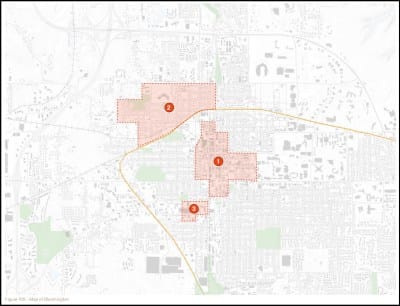Bloomington consultant: Build arts incubator with small venue; keep Waldron; look close at BCT; showcase art in expanded convention center

On Monday, the city of Bloomington released an arts feasibility study done by Trahan Architects, which was commissioned by mayor John Hamilton’s administration.

A key recommendation from Trahan was for the city to keep the Waldron building on Walnut Street as a permanent city arts venue—not just for the five-year commitment that Hamilton made in May 2021.
Paired with the advice on the Waldron was Trahan’s suggestion that Bloomington not build a larger standalone purpose-built performing arts venue.
One possibility, which a 2021 task force had recommended for more investigation, had been the idea of selling the Waldron and using the proceeds to construct a standalone performance facility.
The conclusion from Trahan’s investigation: Bloomington doesn’t have enough population or projected growth to support another standalone performing arts center.
Instead of a large purpose-built performance venue, Trahan recommends building a new arts and culture “incubator.” The idea would be to offer space to artists an affordable price point, where they could create their work. Three general spots in the city are identified in Trahan’s report as good locations for an arts incubator: downtown, the former IU Health hospital site (Hopewell), and the Maple Heights/Crestmont neighborhood.
Trahan’s report includes a case study for an arts incubator in the Hopewell redevelopment area, at 714 S. Rogers Street.
But the incubator space should include some performance space, too, according to Trahan’s report. There’s a need for a small arts facility with 100 seating to 200 standing capacity, according to Trahan. A venue that big would support smaller performances and could be used for rehearsing and recording, according to Trahan.
Trahan’s report also recommends that Bloomington consider an expanded convention center as another place to showcase local artists, by including murals, sculptures, performance venues, and galleries so that Bloomington artists are exposed to the broader audience of convention attendees.
Trahan also recommended in its report that the Buskirk-Chumley Theater get some attention—to investigate the potential flexibility of its seating configurations, backstage areas, and rehearsal spaces.
In addition to physical infrastructure, Trahan’s report recommends more support for the arts through better programming and marketing.
Youth programming is mentioned specifically as a need. Trahan says Bloomington should invest in all-ages spaces that serve K-12 students.
Trahan’s report also calls for more community programming like neighborhood showcases, concerts, public art commissions, murals, neighborhood public art stewardship programs, or neighborhood festivals.
Marketing should be developed that reflects Bloomington’s role as “a regional leader in the creation of arts and culture,” according to Trahan’s report.
The report released on Monday was called for in Bloomington’s planned expenditures for American Rescue Plan Act money. The initial amount described for a feasibility study for a purpose-built performing arts venue was around $50,000.
Based on Bloomington’s online financial records, the city has now made eight payments in 2022 totaling $100,149.85 to Trahan Architects, starting at the end of May, for an “arts feasibility study.”
The Sept. 30, 2022 payment to Trahan is described in the city’s online financial records with the phrase “100% complete.”




Comments ()